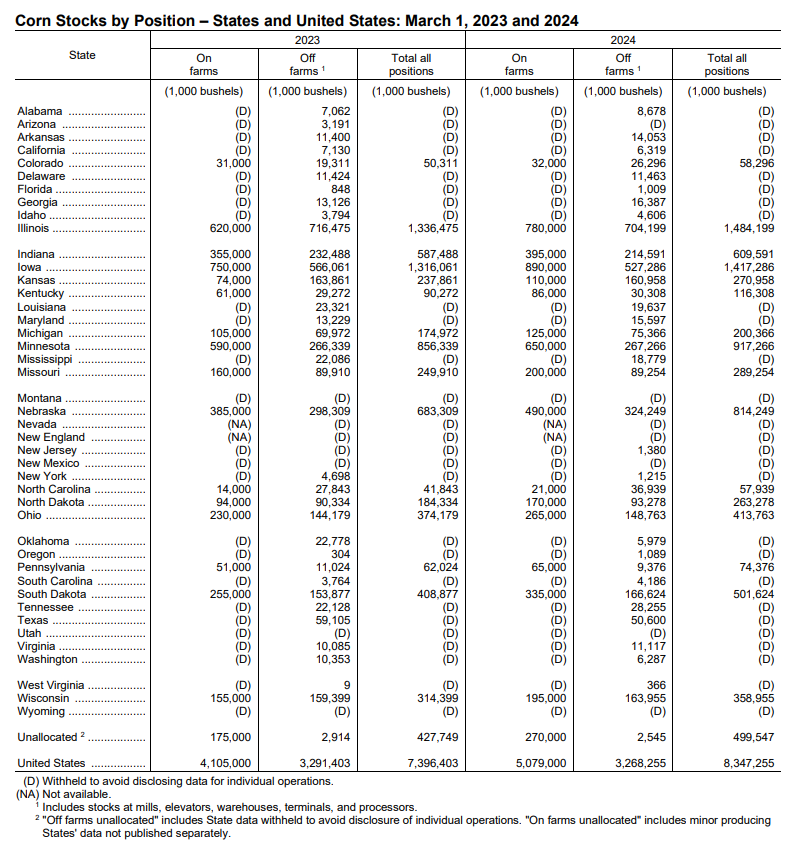U.S. Farmers Holding On To Large Corn and Soybean Stocks
Reuters’ P.J. Huffstutter and Karl Plume reported Monday that “after stockpiling crops for much of this season due to low prices, many farmers in the world’s largest corn-producing nation continue to shun buyers despite few signs that prices will improve. Grain supplies are ample and early ratings of summer crops are the best in years.”
“A larger-than-normal volume of grain remains unsold, according to Reuters interviews with 15 grain farmers across the U.S. Midwest,” Huffstutter and Plume reported. “By September 2025, U.S. corn inventories are expected to reach a six-year high, according to the U.S Agriculture Department.”
Huffstutter and Plume reported that “some buyers are trying to pry grain away from farmers by offering premiums for immediate supplies to fill near-term needs, but are lowering prices once those orders are filled. Archer-Daniels-Midland on Friday offered farmers a 7-cent-per-bushel premium for corn delivered to its Decatur, Illinois, processing plant by Sunday versus later in the month. At ADM’s Cedar Rapids, Iowa, plant, that premium is 15 cents. Such offers of a few extra pennies per bushel can amount to thousands of dollars per grain transaction.”
Current On-Farm Stocks
While the USDA will update on-farm corn stocks numbers at the end of this month, Huffstutter and Plume reported that “U.S. corn supplies stored at the farm level stood at just over 5 billion bushels as of March 1, the second-highest on-farm stocks on record for that date, according to USDA. On-farm stocks represented 60.85% of the entire U.S. corn supply, the largest share since 2005.”
According to the USDA’s March Grain Stocks report, which contains the most recent available data, the 5.08 billion bushels of corn being held on U.S. farms is up 24% from the amount held on farms in 2023.
In Illinois, on-farm corn stocks were at 780 million bushels, as of March 2024, an increase of 160 million bushels over 2023. In Iowa, on-farm stocks were at 890 million, as of March 2024, an increase of 140 million bushels over 2023. In Nebraska, on-farm stocks were at 490 million bushels, as of March 2024, an increase of 105 million bushels over 2023.

In addition to corn, U.S. farmers are holding on to soybeans on-farm at a much higher level in 2024 than in 2023. The March grain stocks report says that “soybean stocks stored on farms are estimated at 933 million bushels, up 24 percent from a year ago.”
In Illinois, on-farm soybean stocks were at 170 million bushels, as of March 2024, an increase of 45 million bushels over 2023. In Iowa, on-farm soybean stocks were at 145 million bushels, as of March 2024, an increase of 25 million bushels over 2023. In Minnesota, on-farm soybean stocks were at 120 million bushels, as of March 2024, an increase of 21 million bushels over 2023.
Why Aren’t Farmers Selling?
Huffstutter and Plume reported that “South Dakota farmer Eric Kroupa received a flurry of calls from grain dealers and ethanol plants asking to buy the corn locked away in his bins when prices neared 4-1/2-month peaks last month. He sold some, but is waiting for buyers to up their bids to sell more. Prices have since eased and are hovering just above three-year lows posted in February.”





